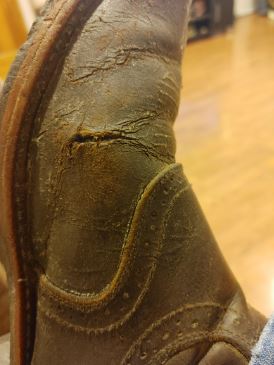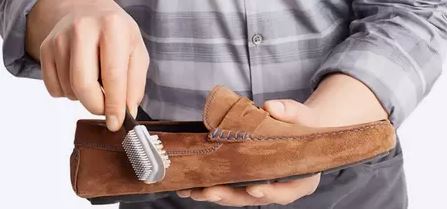When to Repair or Replace Your Shoes: Expert Advice on Common Damage
One of the standout benefits of welted footwear is the ability to replace worn soles with relative ease. However, sole replacement is far from the only solution available when shoes begin to show signs of use. Many types of deterioration can be addressed by a skilled cobbler, although there are a few exceptions where repairs may not be worthwhile. Let’s explore the most frequent forms of shoe damage, highlighting which ones are typically fixable—and when it may be time to move on.
Addressing Heel Wear
Heels often show the earliest signs of wear. For leather-soled shoes, it’s common to have a rubber insert on the rear portion of the heel, while the rest remains leather. In contrast, shoes with rubber soles generally feature full rubber heels. How soon you’ll need to replace the heel depends largely on your gait and how frequently you wear the shoes. It could be anywhere from a few months to several years.
To prevent further damage, heels should be replaced before the rubber component is entirely worn out. Allowing the wear to extend into the leather lifts beneath can increase repair costs, as these layers aren’t designed for contact with the ground. Heel repair costs tend to range from $15 to $30, though rates may vary depending on your location. Another issue that can occur is separation between heel layers or from the sole, which can often be repaired with adhesive at minimal expense.

Repairing Soles: Partial and Full Replacement
When leather soles begin to wear thin, you’ll likely need either a partial or full replacement. In most cases, a half sole is sufficient. This repair involves replacing the outer part of the sole that contacts the ground while leaving the mid-section (or waist) intact. Half soles are usually installed in tandem with new heels.
Rubber-soled shoes, on the other hand, generally require a complete resole. Since the rubber doesn’t allow for seamless sectioning like leather, replacing the entire sole ensures a proper fit and appearance.
A worn-down sole isn’t inherently dangerous, even if the stitching becomes exposed—especially at the toe, which tends to wear quickest. The outsole is usually glued and stitched using a method that keeps each stitch secure independently, reducing the chance of unraveling. However, if the sole wears past this point and begins damaging the welt, a more costly fix may be needed.
If wear is confined to the toe, you can extend the shoe’s life by adding a toe tap or a small leather/rubber patch. When the central sole area starts to feel thin or show holes, that’s a clear sign it’s time for a full or half resole. Expect to pay between $70 and $120 for a partial sole, and anywhere from $130 to $200 for full replacements. Many high-end shoe brands offer factory resoling services, sometimes priced up to $300. For custom-made shoes, it’s standard practice to return them to the original maker for repairs.
Replacing Worn Heel Linings
The inside heel area takes a lot of abuse, often resulting in worn or torn lining leather. This is a common issue and usually not difficult to resolve. A cobbler can insert a fresh piece of lining leather, attaching it with glue and thinning the edges so it blends seamlessly. The top edge is sewn into the original seam, making the repair invisible from the outside.
Depending on the materials and labor involved, a new heel lining can cost between $25 and $60. There are also stick-on patches available for a DIY fix, but they generally don’t offer the durability or comfort of a professional job.
Fixing Elastics and Buckles
Shoelaces are easy enough to replace, but what about other closure mechanisms? Shoes that rely on elastic or buckles can also be repaired when these parts wear out. For instance, Chelsea boots often develop stretched or weakened elastics over time. Fortunately, these inserts can be swapped out without too much trouble.
Similarly, monk straps and jodhpurs may suffer from broken buckles. While some effort is required to stitch through the upper and sometimes adapt to a new buckle style, it’s generally a manageable fix. Worn leather straps can also be replaced, though the alteration may be slightly visible depending on the placement and leather match.
Dealing with Surface Scratches
Leather uppers are prone to scuffs and scratches, particularly from impact with sharp or abrasive surfaces. If the damage is shallow, it may be possible to buff it out or conceal it with polish. For deeper gashes, leather repair paste, adhesive, and a touch of color-matching cream may help improve the appearance.
You can attempt these repairs at home, but cobblers usually achieve cleaner and longer-lasting results. It’s easier to restore scratches in rigid parts of the shoe, like the toe box, than in more flexible areas. The cost of such cosmetic repairs varies based on the depth and location of the damage.
Managing Cracks in Upper Leather
Among all types of shoe damage, cracks in the upper leather are perhaps the most disheartening. They tend to form along the flexing area between the toe and the laces, known as the vamp. These cracks develop gradually, even with regular care, and are an inevitable sign of aging in most shoes.
Although some cracks can be patched with new leather pieces, these repairs often remain visible and may not restore the shoe’s original aesthetic. This kind of fix is rarely attempted unless the shoes are of exceptional sentimental or monetary value.

When Insoles Break Down
The insole is a crucial structural component in welted footwear. It supports the foot and serves as the foundation upon which the rest of the shoe is built. With frequent use, moisture from sweat and repeated stress can eventually cause the insole to deteriorate or even crack.
Fixing a damaged insole is no small task. In most cases, it requires sending the shoes back to the manufacturer for an intensive refurbishment that may leave only the upper intact. Given the high cost and complexity, this repair is often not worth pursuing unless the rest of the shoe is in outstanding condition.
Other Minor Repairs Worth Considering
Aside from the major fixes discussed above, there are several smaller issues that can arise with regular use. Stitching might come undone along the upper, or the connection between the outsole and welt may weaken. Separations between the heel and the sole or among heel layers are also fairly common. Most of these problems are straightforward and inexpensive to repair.
While this guide covers many typical shoe repairs, countless other issues can occur depending on how your shoes are worn and maintained. Some are rare, while others happen more frequently. The key takeaway is this: with good care and timely maintenance, many problems can be fixed—prolonging the life of your favorite footwear and saving you money in the long run.
Read Also: When to Replace Your Athletic, Walking, Running, or Exercise Shoes
Frequently Asked Questions
What types of shoe damage can be repaired?
Most damage, including worn heels, soles, loose stitching, broken buckles, and heel lining tears, can be professionally repaired. The upper leather and insole are harder to fix, especially if they’re cracked or severely damaged.

How do I know when my shoes need new heels?
If the rubber or leather on the heel is significantly worn or uneven, or if the heel is separating from the sole, it’s time for a replacement to prevent further damage to the shoe structure.
What is the difference between a half sole and full sole replacement?
A half sole replacement repairs only the front part of the sole, preserving the waist and back. A full sole replacement involves removing the entire sole and sometimes parts of the heel, which is more common for rubber-soled shoes.
Can cracked leather on the shoe’s upper be repaired?
Minor scratches can be buffed or filled in, but deep cracks—especially on flexing areas—are difficult to repair seamlessly. Some cobblers may patch them, but the result may not be visually perfect.
Is it worth resoling old shoes?
Yes, if the upper leather is still in good condition. Resoling high-quality welted shoes can add years to their life and is usually more cost-effective than buying new shoes of similar quality.
What causes the inner heel lining to wear out?
Friction from the heel rubbing against the back of the shoe during walking causes lining wear. It’s a common issue and can be easily fixed by replacing the damaged lining leather.
Can elastic inserts on Chelsea boots be replaced?
Yes, worn-out elastics can be removed and new ones stitched in. A professional cobbler can do this while maintaining the shoe’s original appearance and fit.
How long does a typical shoe repair take?
Depending on the type of repair, it can take anywhere from a day to a week. More complex jobs like full resoles or factory repairs might take longer.
When is it time to retire a pair of shoes?
If the insole is cracked or the upper leather is extensively damaged and repair would cost more than replacement, it might be time to replace the shoes—especially if comfort and structure are compromised.







